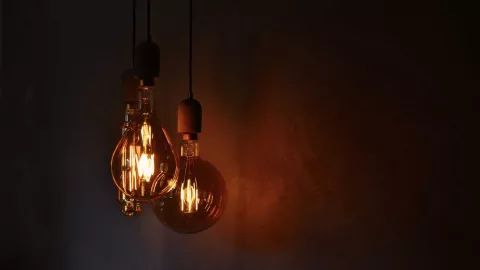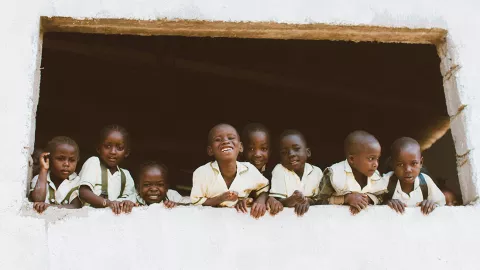This is a story that starts with the switch down, but ends with the hope of the switch going up for the whole planet.
It is said that at some times the switch is up, at other times it is down. A popular pun that serves to signal good and less good phases of life. But the object itself, which every day, as if by magic, illuminates life whenever we need it, seems such a simple thing, so routine, that we forget to give it the importance which, in fact, it has. Imagine a few hours without electricity at night. The washing machines and dishwashers are still running, while your favorite TV series awaits you on the sofa, all at the touch of just one button, that one switch. Turn it on and nothing happens, and you end up walking around the house, literally, topsy-turvy looking for a substitute, which usually comes in the form of a lantern or a candle. Dimly lit by the alternative light source, you hope it to be a very fleeting thing and perhaps then you will begin to realize how electricity is such a precious asset for our day-to-day lives. What if we tell you that 789 million people in the world still live without electricity?
More than 10% of the population without access to energy
The figures are from the World Bank's latest energy progress report and represent more than 10% of the world's population without access to energy, with sub-Saharan Africa being the most affected area of the planet. Since 2010 the number of people with access to energy has been increasing, but it needs to grow faster so that universal access to electricity is achieved by 2030, as well as access to “clean cooking”, as defined by the United Nations in the Sustainable Development Goals. If there are 789 million people in darkness on the planet, there are still more - around 2.8 billion - who depend on wood, coal and agricultural waste to cook and heat themselves.
Even so, in the past decade, progress has been remarkable: in 2010, 1.2 billion people did not have access to electricity; by 2016 that number had dropped to 1 billion, and in 2018 it reached 789 million. On the other hand, the use of clean stoves, globally, went from 57% in 2010 to 63% in 2018.
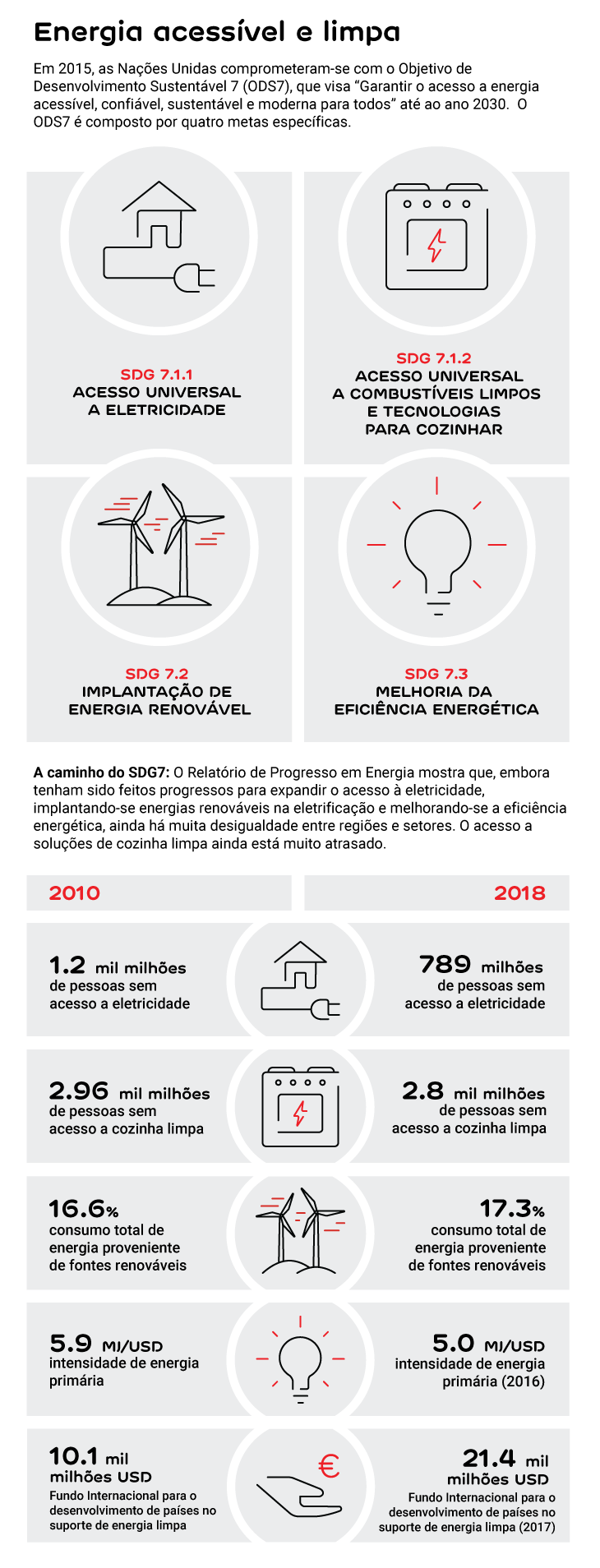

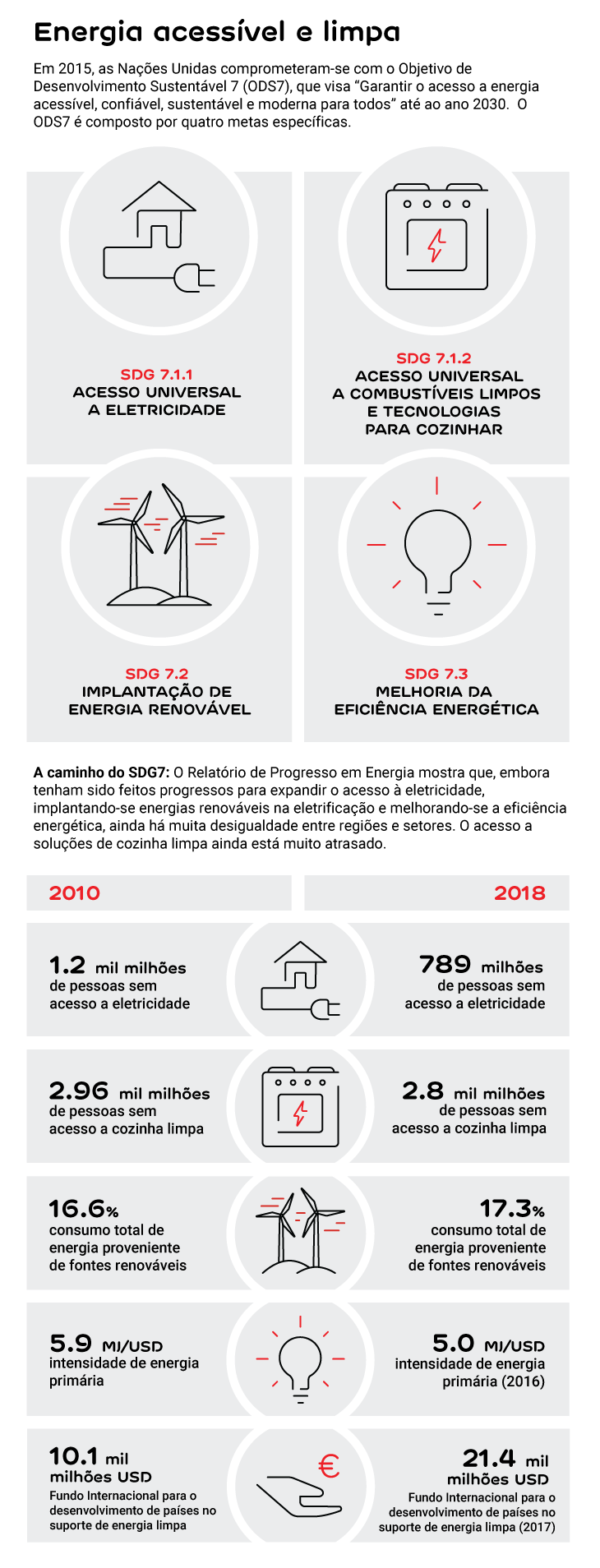
At full speed...
“Although we are on the right track, we are not at the right speed to achieve those 2030 goals. "This is recognized by most of the agents that analyze this theme," evaluates Duarte Bello, administrator of EDP Renováveis (EDPR).
The EDPR administrator also says that this is a problem that is divided into two areas: “An area that encompasses the bulk of the population that lacks access to electricity, and Africa is the most emblematic continent from this point of view, but with a very relevant element: the number of people without access to energy is not expected to decrease much, due to the demographic issue of a high birth rate. For this reason, the issue of speed here is particularly important and poses a double challenge: electrification with renewable energies, because electrification alone does not solve the climate problem. Then, in the second area, there are also the pockets of energy poverty on other fringes of the world population, even in OECD countries, developed countries."
In these cases, the problem usually does not have to do with the technology needed to electrify, but with more complex solutions from the legislative point of view. “Like social tariffs to support electrification, to support the consumption of people who do not have enough heating or electricity for basic necessities. "Here, too, there are inequalities that should be highlighted, which are related to support from the regulatory point of view,” adds Duarte Bello.

“If the problem was easy to solve, the solution would have already been found. "Access to energy is a complex issue, rooted in several challenges, including financial, political, human capacity and socio-economic ones," Marcus Wiemann, Executive Director of the Alliance for Rural Electrification (ARE)
How to alleviate global energy poverty?
Estimates by SEforALL (Sustainable Energy for All), an entity in which EDP's CEO, António Mexia, is Chairman of the Administrative Board, show that 80% of energy poverty is found in rural areas, where the extension of national electricity grids is technically more difficult, expensive and inefficient. On the other hand, the decentralized production and distribution of electricity, through local systems, such as autonomous systems without connection to national electricity networks (off-grid), are, in most cases, the most competitive solution in rural areas. This has been the focus of the Alliance for Rural Electrification (ARE), led by the German Marcus Wiemann.
“Guaranteeing access to energy for the most remote and deprived communities, enabling the creation of sustainable ecosystems is, therefore, a necessary condition to break the cycle of poverty and contribute to the social and economic development of these regions,” says the Executive President of EDP, António Mexia.
To the economist João Duarte Cunha, Director of the Department of Energy Initiatives and Partnerships of the African Development Bank, “access to finance continues to be one of the biggest challenges to the growth of decentralized energy access businesses in Africa". "It is necessary to draw the attention of private individuals with business models anchored in digital solutions - such as mobile money - and to launch several initiatives, with risk mitigation instruments, to give a push to commercial investments in decentralized energy at scale."
For Africa...
The solution is not easy. But ARE, as well as the African Development Bank and EDP, show sufficient determination to continue to walk on a joint path to tackle this energy poverty.
good example of this is EDP's Energy Access Fund (A2E).
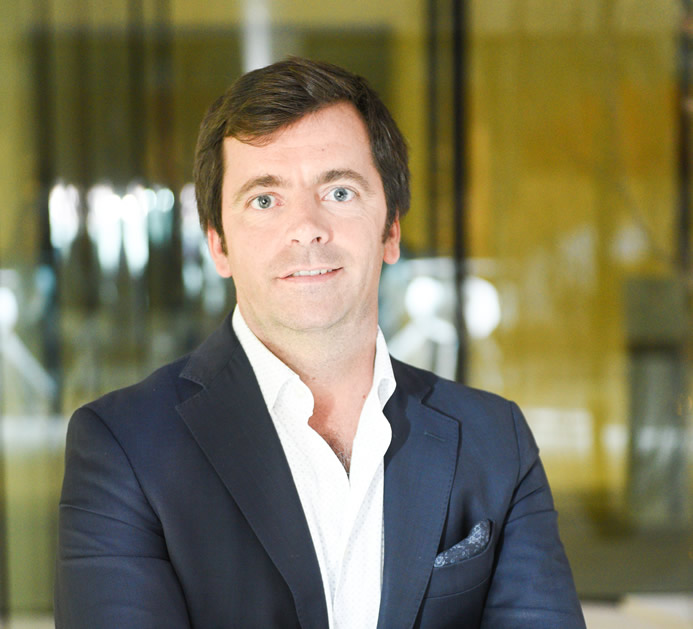
“EDP's Energy Access Fund was started in 2018, with more than 100 applications, which led to us distributing around half a million euros for 5 projects. "We have very interesting projects, in Kenya, Malawi, Tanzania and Mozambique, which have responded very effectively to the problem of access to energy in rural African areas," says Duarte Bello.
And since a winning formula should not be changed, in October 2019 registrations for the 2nd edition were launched. "We had more than 160 applications and we are also going to distribute half a million euros for these various projects - which have now extended to Nigeria - and we also expect it to be a success," says Duarte Bello.
“Since this fund maintains a philanthropic component, which EDP has had in its DNA since the beginning, our Energy Access team has also decided to look for the most economical component, in which we partnered with existing companies, startups and other relatively small companies that contribute to energy access solutions, either through solar kits or through mini-grids. "And we already have two investments in this regard, in which we invested around six million euros. "SolarWorks, in Mozambique, and another very recent one, Rensource,in Nigeria," concludes the EDPR administrator.
… Light up, light up
Marcus Wiemann shares the vision and objectives of this EDP program: “The vision behind A2E is fully compatible with ARE's mission, to activate markets for affordable energy services and create local jobs and inclusive economies. "We have already seen that the use of energy must be aligned in order to trigger economic development, through the creation of revenues for the local population."
With this in mind, PURE was born - the Productive Use of Renewable Energy - through which ARE developed a sustainable approach with three levels, as its Executive Director explains. “The economic, since it generates revenue for local companies; the social, with economic and health benefits for the local population; and the environmental, with the use of renewable energy.”
PURE also allows the diversification of economic resources, allowing the local community to go beyond traditional economic activities. “PURE means local jobs created directly, since renewable energy equipment needs to be installed, handled and maintained, and indirectly, since access to electricity favors the creation and expansion of businesses."
On the way to electrification...
Equally ambitious is the New Deal on Energy for Africa strategy of the African Development Bank, which set the goal of achieving universal access to energy in this continent by 2025. “In addition to financing interventions on a smaller scale, the Bank is aware of the important role of decentralized renewable energy solutions (DRE), which act to accelerate this access to energy,” says João Duarte Cunha.
In 2019, the Bank transformed the Energy Fund for Africa (SEFA), with a window of new investments in the form of concessions, which improved project financing, through innovative technologies in challenging geographies. “Our focus is on mini-grids (electricity distribution systems that have their own energy resources) to accelerate access to energy for deprived populations; on sustainable batteries, to support clean generation capacity; and on energy efficiency, to optimize energy systems." SEFA 2.0 should contribute to electricity for more than 7 million families by 2030, a reasonable goal, but one that will only be achieved with the entry of more investments to the sector. We are talking about regions where networks perform intermittently and the priority is electrification, of houses, services, everything. Perhaps now, with solar energy as a lever, since the price of solar has fallen dramatically, by around 95%, it will be able to attract those investments," argues João Duarte Cunha.
… with lithium-ion batteries…
With solar energy more affordable, and storage as well - as battery costs for off-grid systems decreasing since 2013 - the challenge has not been overcome, but we are heading there. “This is one of the reasons why ARE signed a partnership for energy storage, led by the World Bank, which catalyzes energy storage markets in emerging countries,” says Marcus Wiemann. One of the examples of this trend has been the increasing use of lithium-ion batteries in off-grid systems. “While storage in mini-networks, 5, 10 years ago, was done predominantly with lead acid batteries, lithium ions have been used in some of the most recent mini-networks,” continues ARE's Executive Director.
… and renewables increasingly accessible
“There must be technological solutions that are economically competitive, otherwise they are not scalable." Of course, this involves several stakeholders and one of them, obviously, is the governments that have to facilitate the access to these technologies and new business models by their populations. "I give the example of our activity in Nigeria, which depends on concessions that are given to certain energy trading markets, so that the operators can invest some initial money with certainty, set up an infrastructure and then have time to take advantage of future investment,” contends the EDPR administrator.
And nowadays with alternatives that are more efficient, faster and cheaper, the bait is launched for investment. “Storage, which in renewables is associated with batteries, solves one of the two problems that renewables had since their infancy." The first had to do with high cost and the second with intermittence. Regarding the cost, everyone - governments and agents - already recognizes that the cheapest source of energy is the renewable. This battle has already been won. But there is a fact here: there is not always sun, nor is there always wind, which means that the issue of intermittence must also be resolved in the long term. The batteries seem to be the most obvious way to do it, ” continues Duarte Bello.
The 3rd revolution of the renewables
There is already talk of a third revolution of renewables that is precisely about solving the problem of intermittence. “Due to this same intermittence, renewables had to be complementary to other sources of electricity generation, such as gas plants, etc. With batteries becoming more and more accessible, this need will decrease, and renewables will become the basis of energy production in each country. "For this to happen, there needs to be stability in the supply of that energy, such a stability being achieved through batteries. "We are talking about a very relevant change in the energy matrix and in the functioning of the electricity sector in any country, compared with what we knew 10 years ago,” evaluates Duarte Bello.
Some pilot, research projects, such as one in Romania with lithium batteries, gave EDP the skills, know-how and experience to carry out projects on a commercial scale, such as one recently in the USA. “We recently signed a long-term agreement for a solar project - with a capacity of more than 200 MW - that has a battery attached. "And it is no longer a 1 MW battery, but dozens of MW. "This was a requirement imposed on us by those who ask for the energy. "In other words, it is no longer just us, as producers, who are advancing this issue, but also those who buy the energy,” concludes Duarte Bello.
For a problem, several solutions
Just as the renewables in the beginning had a high cost, the various agents believe that with economy of scale, the costs will become increasingly accessible. And here the solution will be mixed: between renewables and batteries. “I would even say with three routes: solar, wind and batteries. "And this will not be a reality for many years to come. Still, during this decade it will be the most common," defends the EDPR administrator.
The African Development Bank has also made every effort in this direction. Recently, the Desert to Power initiative was started. “This is a solar project that extends across the entire Sahel region - an African strip measuring 5,400 km in length, between the Sahara desert and the Savannah of Sudan, from Senegal to Somalia, and has the objective of bringing electricity to 250 million people, taking advantage of the region's abundant solar resources. "This is the African area with the highest rates of access to modern energy, having decentralized solar energy as a lever. "Here it is a matter of finding a formula between storage and efficiency, which is always difficult due to the variability of the network, but which will involve the use of highly efficient technological equipment and the optimization of consumption,” says João Duarte Cunha.
“In order to create confidence in clean energies, the first instances of access to energy in these countries must be done properly, according to their needs and availability of payment, supported by adequate regulation and predictable policies. "Here, ARE's advice and collaboration with international development agencies and organizations, as well as with governments, ministries and regulators, is as crucial as combining B2B companies and training,” evaluates Marcus Wiemann.
Nobody expects that, tomorrow, the whole world will live with "the switch up". Because even if the current pace is maintained, it is estimated that, by 2030, 620 million people will still live without electricity. But one thing is certain, when they achieve it, it will no longer be through the traditional electric grid, it will be through sustainable energy.
